Lingkai Kong
College of Computing, Georgia Institute of Technology
What is the Right Notion of Distance between Predict-then-Optimize Tasks?
Sep 11, 2024Abstract:Comparing datasets is a fundamental task in machine learning, essential for various learning paradigms; from evaluating train and test datasets for model generalization to using dataset similarity for detecting data drift. While traditional notions of dataset distances offer principled measures of similarity, their utility has largely been assessed through prediction error minimization. However, in Predict-then-Optimize (PtO) frameworks, where predictions serve as inputs for downstream optimization tasks, model performance is measured through decision regret minimization rather than prediction error minimization. In this work, we (i) show that traditional dataset distances, which rely solely on feature and label dimensions, lack informativeness in the PtO context, and (ii) propose a new dataset distance that incorporates the impacts of downstream decisions. Our results show that this decision-aware dataset distance effectively captures adaptation success in PtO contexts, providing a PtO adaptation bound in terms of dataset distance. Empirically, we show that our proposed distance measure accurately predicts transferability across three different PtO tasks from the literature.
DeepTTV: Deep Learning Prediction of Hidden Exoplanet From Transit Timing Variations
Sep 06, 2024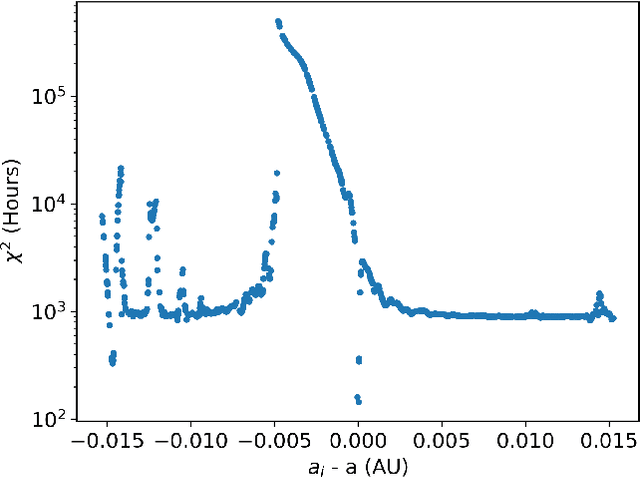
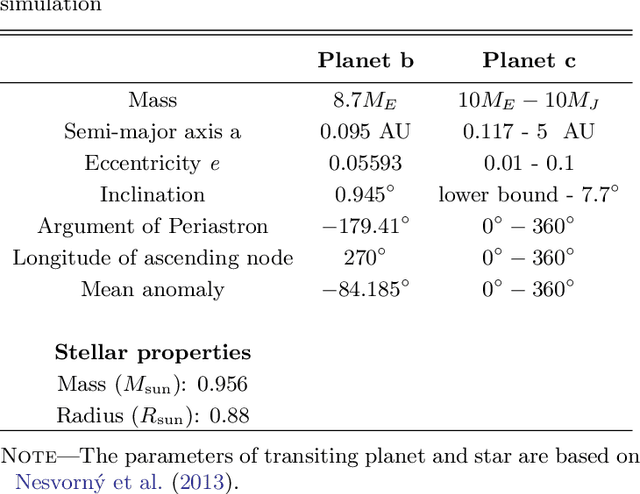
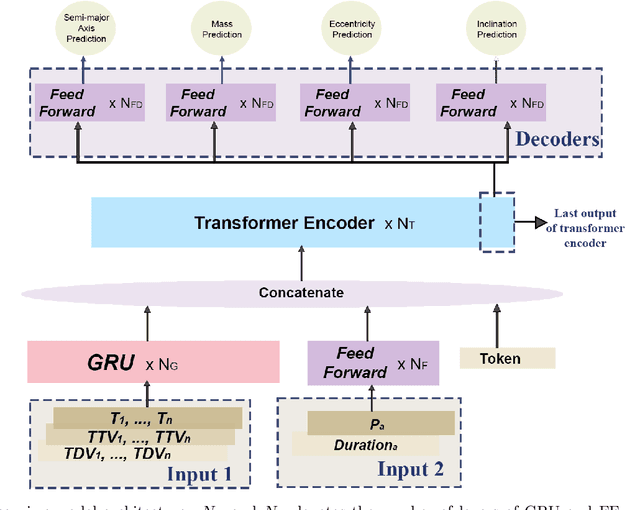

Abstract:Transit timing variation (TTV) provides rich information about the mass and orbital properties of exoplanets, which are often obtained by solving an inverse problem via Markov Chain Monte Carlo (MCMC). In this paper, we design a new data-driven approach, which potentially can be applied to problems that are hard to traditional MCMC methods, such as the case with only one planet transiting. Specifically, we use a deep learning approach to predict the parameters of non-transit companion for the single transit system with transit information (i.e., TTV, and Transit Duration Variation (TDV)) as input. Thanks to a newly constructed \textit{Transformer}-based architecture that can extract long-range interactions from TTV sequential data, this previously difficult task can now be accomplished with high accuracy, with an overall fractional error of $\sim$2\% on mass and eccentricity.
Balancing Act: Prioritization Strategies for LLM-Designed Restless Bandit Rewards
Aug 22, 2024Abstract:LLMs are increasingly used to design reward functions based on human preferences in Reinforcement Learning (RL). We focus on LLM-designed rewards for Restless Multi-Armed Bandits, a framework for allocating limited resources among agents. In applications such as public health, this approach empowers grassroots health workers to tailor automated allocation decisions to community needs. In the presence of multiple agents, altering the reward function based on human preferences can impact subpopulations very differently, leading to complex tradeoffs and a multi-objective resource allocation problem. We are the first to present a principled method termed Social Choice Language Model for dealing with these tradeoffs for LLM-designed rewards for multiagent planners in general and restless bandits in particular. The novel part of our model is a transparent and configurable selection component, called an adjudicator, external to the LLM that controls complex tradeoffs via a user-selected social welfare function. Our experiments demonstrate that our model reliably selects more effective, aligned, and balanced reward functions compared to purely LLM-based approaches.
Learning Graph Structures and Uncertainty for Accurate and Calibrated Time-series Forecasting
Jul 02, 2024Abstract:Multi-variate time series forecasting is an important problem with a wide range of applications. Recent works model the relations between time-series as graphs and have shown that propagating information over the relation graph can improve time series forecasting. However, in many cases, relational information is not available or is noisy and reliable. Moreover, most works ignore the underlying uncertainty of time-series both for structure learning and deriving the forecasts resulting in the structure not capturing the uncertainty resulting in forecast distributions with poor uncertainty estimates. We tackle this challenge and introduce STOIC, that leverages stochastic correlations between time-series to learn underlying structure between time-series and to provide well-calibrated and accurate forecasts. Over a wide-range of benchmark datasets STOIC provides around 16% more accurate and 14% better-calibrated forecasts. STOIC also shows better adaptation to noise in data during inference and captures important and useful relational information in various benchmarks.
Efficient Evolutionary Search Over Chemical Space with Large Language Models
Jun 23, 2024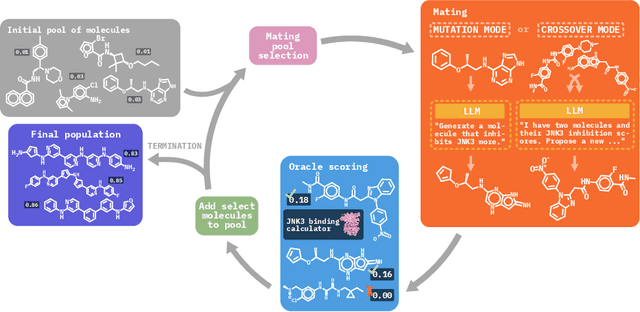
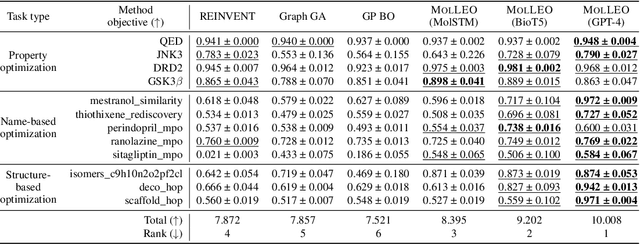
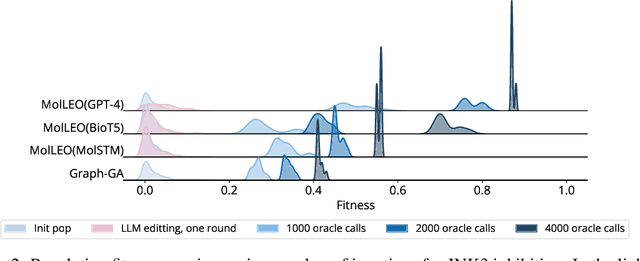

Abstract:Molecular discovery, when formulated as an optimization problem, presents significant computational challenges because optimization objectives can be non-differentiable. Evolutionary Algorithms (EAs), often used to optimize black-box objectives in molecular discovery, traverse chemical space by performing random mutations and crossovers, leading to a large number of expensive objective evaluations. In this work, we ameliorate this shortcoming by incorporating chemistry-aware Large Language Models (LLMs) into EAs. Namely, we redesign crossover and mutation operations in EAs using LLMs trained on large corpora of chemical information. We perform extensive empirical studies on both commercial and open-source models on multiple tasks involving property optimization, molecular rediscovery, and structure-based drug design, demonstrating that the joint usage of LLMs with EAs yields superior performance over all baseline models across single- and multi-objective settings. We demonstrate that our algorithm improves both the quality of the final solution and convergence speed, thereby reducing the number of required objective evaluations. Our code is available at http://github.com/zoom-wang112358/MOLLEO
Time-Series Forecasting for Out-of-Distribution Generalization Using Invariant Learning
Jun 13, 2024Abstract:Time-series forecasting (TSF) finds broad applications in real-world scenarios. Due to the dynamic nature of time-series data, it is crucial to equip TSF models with out-of-distribution (OOD) generalization abilities, as historical training data and future test data can have different distributions. In this paper, we aim to alleviate the inherent OOD problem in TSF via invariant learning. We identify fundamental challenges of invariant learning for TSF. First, the target variables in TSF may not be sufficiently determined by the input due to unobserved core variables in TSF, breaking the conventional assumption of invariant learning. Second, time-series datasets lack adequate environment labels, while existing environmental inference methods are not suitable for TSF. To address these challenges, we propose FOIL, a model-agnostic framework that enables timeseries Forecasting for Out-of-distribution generalization via Invariant Learning. FOIL employs a novel surrogate loss to mitigate the impact of unobserved variables. Further, FOIL implements a joint optimization by alternately inferring environments effectively with a multi-head network while preserving the temporal adjacency structure, and learning invariant representations across inferred environments for OOD generalized TSF. We demonstrate that the proposed FOIL significantly improves the performance of various TSF models, achieving gains of up to 85%.
Time-MMD: A New Multi-Domain Multimodal Dataset for Time Series Analysis
Jun 12, 2024



Abstract:Time series data are ubiquitous across a wide range of real-world domains. While real-world time series analysis (TSA) requires human experts to integrate numerical series data with multimodal domain-specific knowledge, most existing TSA models rely solely on numerical data, overlooking the significance of information beyond numerical series. This oversight is due to the untapped potential of textual series data and the absence of a comprehensive, high-quality multimodal dataset. To overcome this obstacle, we introduce Time-MMD, the first multi-domain, multimodal time series dataset covering 9 primary data domains. Time-MMD ensures fine-grained modality alignment, eliminates data contamination, and provides high usability. Additionally, we develop MM-TSFlib, the first multimodal time-series forecasting (TSF) library, seamlessly pipelining multimodal TSF evaluations based on Time-MMD for in-depth analyses. Extensive experiments conducted on Time-MMD through MM-TSFlib demonstrate significant performance enhancements by extending unimodal TSF to multimodality, evidenced by over 15% mean squared error reduction in general, and up to 40% in domains with rich textual data. More importantly, our datasets and library revolutionize broader applications, impacts, research topics to advance TSA. The dataset and library are available at https://github.com/AdityaLab/Time-MMD and https://github.com/AdityaLab/MM-TSFlib.
Quantitative Convergences of Lie Group Momentum Optimizers
May 30, 2024Abstract:Explicit, momentum-based dynamics that optimize functions defined on Lie groups can be constructed via variational optimization and momentum trivialization. Structure preserving time discretizations can then turn this dynamics into optimization algorithms. This article investigates two types of discretization, Lie Heavy-Ball, which is a known splitting scheme, and Lie NAG-SC, which is newly proposed. Their convergence rates are explicitly quantified under $L$-smoothness and local strong convexity assumptions. Lie NAG-SC provides acceleration over the momentumless case, i.e. Riemannian gradient descent, but Lie Heavy-Ball does not. When compared to existing accelerated optimizers for general manifolds, both Lie Heavy-Ball and Lie NAG-SC are computationally cheaper and easier to implement, thanks to their utilization of group structure. Only gradient oracle and exponential map are required, but not logarithm map or parallel transport which are computational costly.
Trivialized Momentum Facilitates Diffusion Generative Modeling on Lie Groups
May 25, 2024



Abstract:The generative modeling of data on manifold is an important task, for which diffusion models in flat spaces typically need nontrivial adaptations. This article demonstrates how a technique called `trivialization' can transfer the effectiveness of diffusion models in Euclidean spaces to Lie groups. In particular, an auxiliary momentum variable was algorithmically introduced to help transport the position variable between data distribution and a fixed, easy-to-sample distribution. Normally, this would incur further difficulty for manifold data because momentum lives in a space that changes with the position. However, our trivialization technique creates to a new momentum variable that stays in a simple $\textbf{fixed vector space}$. This design, together with a manifold preserving integrator, simplifies implementation and avoids inaccuracies created by approximations such as projections to tangent space and manifold, which were typically used in prior work, hence facilitating generation with high-fidelity and efficiency. The resulting method achieves state-of-the-art performance on protein and RNA torsion angle generation and sophisticated torus datasets. We also, arguably for the first time, tackle the generation of data on high-dimensional Special Orthogonal and Unitary groups, the latter essential for quantum problems.
Convergence of Kinetic Langevin Monte Carlo on Lie groups
Mar 18, 2024



Abstract:Explicit, momentum-based dynamics for optimizing functions defined on Lie groups was recently constructed, based on techniques such as variational optimization and left trivialization. We appropriately add tractable noise to the optimization dynamics to turn it into a sampling dynamics, leveraging the advantageous feature that the momentum variable is Euclidean despite that the potential function lives on a manifold. We then propose a Lie-group MCMC sampler, by delicately discretizing the resulting kinetic-Langevin-type sampling dynamics. The Lie group structure is exactly preserved by this discretization. Exponential convergence with explicit convergence rate for both the continuous dynamics and the discrete sampler are then proved under W2 distance. Only compactness of the Lie group and geodesically L-smoothness of the potential function are needed. To the best of our knowledge, this is the first convergence result for kinetic Langevin on curved spaces, and also the first quantitative result that requires no convexity or, at least not explicitly, any common relaxation such as isoperimetry.
 Add to Chrome
Add to Chrome Add to Firefox
Add to Firefox Add to Edge
Add to Edge